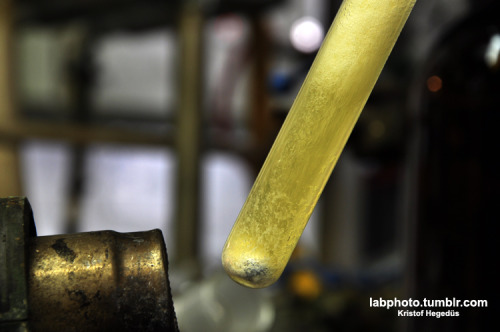| Pages:
1
2 |
blogfast25
International Hazard
    
Posts: 10562
Registered: 3-2-2008
Location: Neverland
Member Is Offline
Mood: No Mood
|
|
Brauer’s synthesis of ZrCl4 can be found on page 1203. It’s the usual carbochlorination of ZrO2 with C and Cl2. The way it’s described is a
little simpler than I imagined it would be bit it’s still no mean feat to pull off at the level of a backyard scientist. I quote:
ZrCl4
ZrO2 + 2C + 2C12 = ZrCl4 + 2 CO
123.2 24.0 141.8 233.0 56.0
An intimate mixture of one part of pure ZrO2 and two parts of
calcined carbon black or sugar charcoal is placed in a porcelain
boat and heated at 500°C in a stream of Cl2; or, preferably,
ZrO2 with no admixtures is chlorinated in a Cl2-CCl4 gas mixture
produced by passing Cl2 through a wash bottle (70°C) filled with
CCl4. The initial chlorination temperature is 350°C, but is
gradually raised to 700°C.
The equipment is similar to that described on p. 889 for the
preparation of BeCl2, except that, when working with Cl3-CCl4,
a trap for the unreacted CC14 must be inserted in line after tube
A. Since ZrCl4, which sublimes at 331°C, is difficult to r e -
condense, it is advisable to use a long tube (600 mm.), preferably
of Vycor. The additional resublimation at 300-350°C is carried
out in a stream of H2, a treatment which more effectively removes
the oxide and FeCl3 present.
Alternate method: The industrial chlorination of ZrC prepared
from ZrSiO4 is described by W. J. Kroll et al. [Trans. Electrochem.
Soc. 89, 263 (1946); 92, 187 (1947); J. Electrochem. Soc. 94,
1 (1948)].
PROPERTIES:
White crystalline powder. Sublimation point 331°C, m.p. (under
pressure) 438°C; d 2.80. Yields a mist of hydrochloric acid in
moist air; violently decomposed by H3O, forming the oxychloride.
Soluble in alcohol and ether. Crystal structure: type D l x .
|
|
|
kristofvagyok
National Hazard
   
Posts: 659
Registered: 6-4-2012
Location: Europe
Member Is Offline
Mood: No Mood
|
|
I have made the reaction and You were right, in these conditions the reduction didn't work. My memory should get a refresh from inorgo chem.

The Zr didn't all reduced, I used ZrOCl2 and found a strange thing: it was refluxed for circa 10 minute in paraffin oil, the resulting sodium lumps
were thrown in propanol, diluted with methanol and finally the not reacting lumps were thrown in water. While it reacted normally a white fluffy
participate formed what didn't dissolved in the water. Any idea anyone? Because if it didn't had reacted at all, it should have left back ZrOCl2 what
is soluble in water.
I have a blog where I post my pictures from my work: http://labphoto.tumblr.com/
-Pictures from chemistry, check it out(:
"You can’t become a chemist and expect to live forever." |
|
|
blogfast25
International Hazard
    
Posts: 10562
Registered: 3-2-2008
Location: Neverland
Member Is Offline
Mood: No Mood
|
|
kristof:
Zirconyl chloride, now known to be [Zr4(OH)12(H2O)16]Cl8(H2O)12 , rather than previously thought to be ZrOCl2.8H2O, would be a very unlikely candidate
for reduction with sodium. All that water, to begin with…
In all likelihood your fluffy precipitate is hydrated zirconia, Zr(OH)4.nH2O, presumably you did get a bit of sodium zirconate(s) (there are several
of them)? These hydrolyse quickly to hydrated zirconia with water. Or some sodium hydroxide: that would hydrolyse the ‘zirconyl chloride’ in a
jiffy: this polymeric structure can only exist in neutral/acidic conditions.
Zirconium’s tendency to form these polymeric cations is also the reason why polymeric structures that include Al and Cl can be formed, used
extensively as the active ingredient in roll on anti-perspirants (from which ‘zirconyl chloride’ can be extracted relatively easily…
[Edited on 16-9-2012 by blogfast25]
|
|
|
| Pages:
1
2 |
|